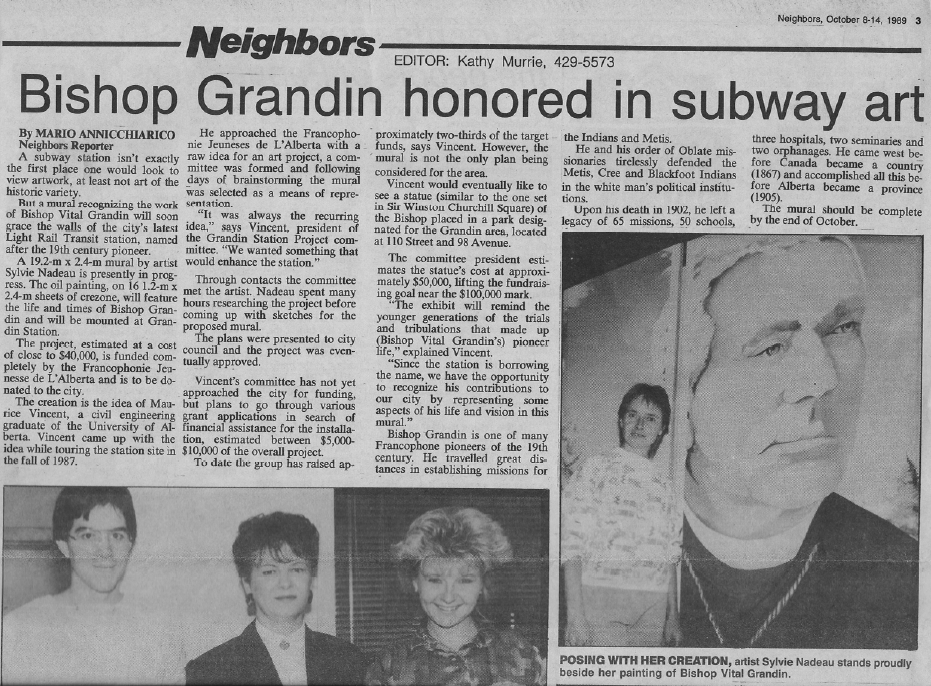
Medical marijuana users are suing Health Canada, in a case that could open doors for other privacy lawsuits against the federal government, and highlight shortcomings in Canada’s Privacy Act, experts say.
“If this case actually proceeded, and resulted in a court decision, it would be precedent-setting,” says Kris Klein, a lawyer at nNovation law firm who has been an advisor to the Privacy Commissioner of Canada.
But it still faces steep hurdles to get there.
The case started last November, after Health Canada sent letters to 40,000 medical marijuana users across the country. Rather than the usual discreet envelopes sent by courier, these went through regular post, and had “Marihuana Medical Access Program” and the patients’ names and addresses clearly displayed on the envelopes.
Patients say this violated their privacy by disclosing to an unknown number of people that they consume and possess marijuana, and that they have grave health conditions. They say it also put them in danger, as many patients in the program also grow marijuana at home, and the information could leave them vulnerable to break-ins and violence.
“That address on that piece of paper outed a lot of people, including designated growers,” says Jason Wilcox, a patient based in Vancouver. As the founder of the Cannabis in Canada Society and an avid social media user, Wilcox isn’t afraid to admit he smokes pot – but he is worried that people could now find out where he grows it. He says for people living in small towns where everyone knows everyone, the problem is even worse.
Jason Wilcox on how he believes the letters endangered growers
Health Canada apologized for the gaffe in a statement on their website, saying it “deeply regrets this administrative error”. But patients have slapped the organization with a class action lawsuit, which is now being waged by four law firms working together across Canada.
The plaintiffs are seeking financial compensation from the federal government, which is a new and barely-explored territory in Canadian privacy law. That’s because Canada’s Privacy Act, which regulates how the federal government handles people’s personal information, doesn’t actually say if people have the right to claim damages if their privacy is invaded. In fact, the only remedy the Act explicitly states is to complain to the federal Office of the Privacy Commissioner.
Because of that, many courts have interpreted the Act to mean that “the legislation didn’t intend for there to be a remedy and that the court doesn’t actually have the right to award a remedy,” says Kate Saunders, a Vancouver lawyer with Branch MacMaster LLP who is handling the medical marijuana case.
Klein says this is one of the areas where he feels the privacy law desperately needs reform. “The Privacy Act right now gives these hollow rights,” he says. “You’re not really giving us rights if, at the same time, you can go ahead and violate them without any negative consequence.”
Listen to Kris Klein on why he thinks the Privacy Act needs reform
The Office of the Privacy Commissioner shares Klein’s concerns. In the watchdog organization’s most recent annual report, then-commissioner Jennifer Stoddart slammed the government’s continued failure to update the Privacy Act, calling it “troubling.” In a speech last November, Stoddart also called for a complete overhaul of the Act, and lamented the lack of penalties for ignoring privacy guidelines. “Wouldn’t it be better to have the force of law to motivate better practices so rather than focusing on reporting breaches, the emphasis would be on avoiding them altogether?” she said.
Saunders and Klein both say they’re seeing an increase in the number of people looking for legal recourse when their privacy is violated. Klein says in the digital age, people are becoming a lot more aware of their personal information, “and as people become more aware, they want to hold organizations accountable if they have that personal information.”
In the Privacy Commissioner’s annual report, Stoddart said that the number of complaints to her Office by citizens has hit a record high two years in a row, with an increase of 133% this past year. While that number was inflated by two significant incidents, Stoddart said it was still concerning.
On the flip side, she also said that data breaches reported by government were at an all-time high for the third year in a row, with 30% more breaches reported than the year before.
But without legal recourse, says Klein, complaining to the Privacy Commissioner is “the end of the road.”
In the absence of hard legislation, the Privacy Commissioner recommends a new, common-law avenue that could offer promise, known as intrusion upon seclusion. It’s borrowed from American case law, and can award damages for an intrusion into someone’s privacy, even if there is no physical loss. This argument will play a key role in the medical marijuana case.
Saunders says they owe a big debt to a ground-breaking 2012 case in the Ontario Court of Appeal, known as Jones v. Tsige. For the first time, a Canadian court used intrusion upon seclusion to award damages for a privacy breach.
“The Jones and Tsige case opened up an avenue that was very exciting for privacy lawyers,” says Saunders, because it meant that, at least in Ontario, there is a common-law right to privacy. “It created a very strong argument that there is a right to privacy in the rest of Canada as well.”
Listen to Kate Saunders on how Jones v Tsige matters to privacy law
Since then, a number of privacy lawsuits in Ontario have relied on intrusion upon seclusion, but the medical marijuana case would be the first to bring it into the federal arena.
“This is why this case is very interesting,” says Saunders. “It provides an opportunity for the government to weigh in on the status of the common-law right to privacy, federally.”
But there’s a long road ahead to get to that point. Saunders says they will be applying for certification next month, which means the court must determine whether it’s appropriate for the case to be treated as a class action.
And even to be certified, Klein says they’ve got an uphill battle. “Most people are not overly sympathetic to the plaintiffs,” he says, saying the incident is largely viewed as a relatively minor mistake.
On top of that, because the Privacy Act doesn’t give any guidelines on what warrants compensation and what doesn’t, he says there’s a lot of risk involved. “The plaintiffs’ lawyers who are taking this on now, they’re gutsy,” he says.
After certification, Saunders says, about 90% of cases will be settled out of court – which means they don’t set any precedent for future cases.
Whichever way this battle goes, there’s no shortage of privacy class actions that are headed for the federal arena right now, including several in Saunders’ office. “But as it stands, we don’t have a good read on which way the federal court is going to lean on them.”
It’s an expensive effort, but Library and Archives Canada is planning to save time and money in the future by making some of its most sought-after files readily accessible to all Canadians.
According to documents obtained through an Access to Information request, 10 million dollars has been committed towards digitizing personnel files of Canadians who served in the First World War.
Fabien Lengellé, the Director General of Services at Library and Archives, said the current budget is closer to 6 million, but the cost will hopefully be worth it when the project is done in 2015.
Lengellé said Library and Archives will spend the next four years scanning and uploading around 650,000 service files from soldiers, officers, nurses, and other military personel. Lengellé estimaes there are between 18 and 20 million pages to digitize and every single one requires extreme caution to handle.
“The operation is a delicate one. The paper is over a hundred years old and it’s pretty frail.”
The following document obtained through an Access to Information Request contains information on the funding for this and other commemorative projects. Click the “Notes” tab to find out more about this project.
Some service files are already online. Click here to view the service file for Canada’s 14th Prime Minister Lester B. Pearson.
The project is one of many projects supported by the federal government to commemorate the 100th anniversary of Canada’s participation in the First World War, but the digitization effort will have long-term benefits.
Lengellé said the files spend a lot of time being trucked back and forth between the preservation centre in Gatineau and the public reading rooms located in Library and Archives Canada’s headquarters in Ottawa.
The preservation centre was built 30 years after Library and Archives’ main building, which wasn’t advanced enough to properly preserve all the old files.
This transportation costs going from Gatineau to Ottawa a lot and runs the risk of permanently damaging these rare historical artifacts.
“To keep manipulating them puts the entire collection in jeopardy,” Lengellé said.
While this digitization project will certainly save money trucking so many files back and forth, the whole endeavour is still costly. Although Lengellé said the money is all coming from Library and Archives’ own budget.
“The bulk of it is going to go to the actual digitization effort,” Lengellé said. “That’s manual labour, that’s very costly.”
The number of people working on the files will change over time, but Library and Archives will be hiring extra staff to help complete the project.
Library and Archives moves around 3,000 files per year for various clients.
In an email, Carleton research professor Tim Cook said the digital archives will be helpful for him and many others.
“Having the 600,000 available will be a new and incredible resource for historians, genealogists, and historically minded Canadians.”
Lengellé said the files are sometimes requested by historical researchers, but a lot of the time it’s relatives of the soldiers wanting to know about their own heritage.
“650,000 people represents 8 per cent of the Canadian population at the time. So anybody who’s got Canadian roots over 100 years old has a relative in those files.”
Library and Archives used to digitize on demand for Canadians living too far from Ottawa to come view the files. Although it saved travel costs for the person who requested the file, Lengellé said digitizing on demand “would cost Canadians 40 cents a page.”
This new digital archive of service files be available to all Canadians completely free of charge.
Although having all the service files in digital format will save some money for both the Library and Archives and Canadians, Lengellé said the project won’t change too much of the department’s regular activities.
“It will make a difference, I’m not downplaying it, but I don’t it would be a major difference on our physical operation in Ottawa.”
After the files are completely uploaded, Library and Archives will start looking at which documents they should digitize next.
“Once we’re done this one, we’ll look at what’s good for clients, what makes sense, and we’ll move on.”
Vanessa Plettell-Chevrier sits comfortably on a chair in the middle of an empty dance studio. She just sent her last group of young dancers for their ballet examinations at the end of what has been a busy weekend for the director.
The dark wooden floors, large panel mirrors and ballet barres running along the walls would leave some feeling cold or even uncomfortable. But for Plettell-Chevrier, it could be her living room.
“Some people are so successful in their businesses and they make piles of money,” Plettell-Chevrier says as she looks around at her surroundings. She has been successful too. “I do it because I love it. I do it because I have to. This is the world I grew up in.”
From the age of four, the Lethbridge native spent endless hours training to become the only thing she ever wanted to be, a ballet dancer.
After finishing her training in Alberta, Plettell-Chevrier realized her dream of becoming a professional dancer with a company in Montreal. However, Ottawa eventually became the city where she would add studio director to her name.
In 1989, Plettell-Chevrier rented a space in the ByWard Market from Theatre Ballet on York Street. Theatre Ballet was taken over and moved to Bank Street, along with Plettell-Chevrier.
“We had people that came and went but it wasn’t ever huge,” Plettell-Chevrier says about the studio’s humble beginnings. “Especially when we only had one studio.”
For years, Plettell-Chevrier says, she taught mostly adults who took classes out of interest, not with the intent of pursuing a career on stage. Since moving to the new location near Old Ottawa South 10 years ago, Plettell-Chevrier says, she now mostly teaches children.
Vanessa Plettell Dance is an educational school that boasts three large studios for aspiring

dancers to train in. Every year, the studio puts on a dance production to give students the professional experience of being on stage.
As opposed to dance studios that focus on competitions as a means of gaining notoriety, Plettell-Chevrier says she seeks to set her students up to pursue dance as a career. She acknowledges that this form of dance training can be intense for some students. However, there are dancers who grew up through the studio that found success as professionals both in Canada and internationally.
Kim Morrison danced at the studio for 10 years after training competitively her entire childhood. She is involved in the studio now as a part-time instructor. Morrison said she appreciated Plettell-Chevrier’s focus on performance, rather than competition.
“She really helped to develop me into a much better dancer, both physically and mentally,” Morrison said, going on to explain how she often felt held back at competitive studios due to the inherently political environment.
The live piano music plays vibrantly from the studio next door as Plettell-Chevrier discusses the emphasis she places on students learning ballet at her school.
“I still believe that ballet is a fundamental of dance,” Plettell-Chevrier says as the music stops momentarily.
“If you build a house and you don’t put up a foundation, it’s not going to work. I cannot explain it any other way. There are no shortcuts in dance.”
In celebration of the studio’s 25th anniversary, students, teachers, parents and Plettell-Chevrier will pack up their ballet slippers and head off to Disney World this summer to perform in the parade and on a professional stage.
In and amidst the ballet examinations, year-end performance showcase and now a trip to Florida, Plettell-Chevrier reflects upon the last quarter-century, “I’ve never been bored,” she says with a smile. “Ever.”
This documentation is link to the website for Vanessa Plettell Dance. I found the website in the early stages of my research by typing “25th anniversary Ottawa” into a Google search. After searching through one or two pages, I came across the link to the studio’s website. The website was extremely helpful for providing me with background information about the studio, Plettell-Chevrier’s career, success stories of dancers who grew up through the studio and contact information. I did a large portion of my preliminary research on the studio’s website.
This documentation is an obituary for Eva von Gencsy that was published by The Globe and Mail in April 2013. Plettell-Chevrier cites von Gencsy as a personal inspiration in her biography on her website. I decided to learn more about von Gencsy after speaking with Plettell-Chevrier who mentioned that von Gencsy passed away last year. I found this obituary on the newspaper’s website. It provided me with more context about the history of jazz-ballet in Canada. Additionally, it helped me understand how Plettell-Chevrier strives to utilize what she learned from von Gencsy during the time they danced together to inform how she runs her studio today.
By Micki Cowan
Twenty-five years after Alain Brosseau was killed in an anti-gay hate crime, new recruits at the Ottawa Police still hear the tragic story of his death.
The story is part of diversity training, where minority representatives speak to new recruits. Luke Smith, committee coordinator for the GLBT police liaison committee, said they tell recruits about Brosseau to teach the history of police and sexual minorities in Ottawa.
“All of our training is Ottawa-specific. An element of that is the history element, and the fact that Alain Brosseau was really the trigger moment for the creation of the committee,” Smith said.
The group, composed of community members and police, was created after Brosseau’s death sparked outcries from the gay community and then other sexual minorities, said committee co-founder David Pepper.
“I think it struck a cord that anyone, including people who weren’t queer, could be attacked because someone thought they were or accused they were or felt they happen to be, as the murderer said, ‘a faggot,’ ” Pepper said.
Brosseau, 33, was walking home from work along the Alexandra Bridge when he was attacked by a group of four men. They made fun of his shoes, and then one of Brosseau’s attackers threw him over the bridge to his death in August 1989.
In court, it came out that the men thought Brosseau was gay. He wasn’t, but his death brought attention to the major issue of hate-inspired actions against sexual minorities in Ottawa in the late 80s and early 90s.
Pepper said he remembers the violence against gays around the time Brosseau was killed – people were who robbed, beaten up and chased because of their sexual orientation.
The brutality and randomness of the murder was part of what finally spurred Pepper to call for change. Pepper said police at the time were not responding to how dangerous the situation was for gay people and sexual minorities at the time.
“We turned to activism,” Pepper said. “Yelling, screaming, having our voices heard, organizing.”
Staff Sgt. Shaun Brabazon with the diversity and racial section of the Ottawa police said he doesn’t have any awareness that there was a different level of response from the police towards the gay community at the time of Brosseau’s death, but did say relations have come a long way since then.
“It’s fair to say that over the years, the police services as a whole has had to work hard to establish those relationships with multiple communities they serve,” Brabazon said.
Aside from the monthly committee, the police now take part in gay community events such as the annual Pride celebration and the Transgender Day Of Remembrance. Despite this progress, Brabazon said they’re always working to keep communication open.
“It’s not a finite job, it’s an ever-increasing action,” he said.
Ongoing issues were addressed at the recent Feb. 24 committee meeting, where members discussed the relationship between queer youth and the police. Gary Leger, current community co-chair, said at the meeting that youth today fear police would out their sexuality to family if caught in a criminal matter.
The committee is considering creating a sub-committee to engage queer youth and address concerns brought up about confidentiality. The decision was put on hold until the next meeting, when the committee will hear from the police’s youth committee.
The mention of Brosseau reminded Pepper how far relations have developed, and also how much there is left to do.
“I take a lot of satisfaction in that 25 years later we don’t fight whether hate crimes exist,” Pepper said. “The struggle is making sure hate has no place in society.”
-30-
*The following picture is a screen shot from the city of Ottawa’s website, where I was able to find David Pepper’s contact information. I found it by trying a variety of Google searches until I was able to narrow the search down to the David Pepper I was trying to reach. It was extremely helpful as it allowed me to contact my main source.
*This is a report prepared by the Ontario Association of Chiefs of Police. One of my sources suggested the document to me, so I Googled it and found the PDF online. The document was helpful in that it allowed me to better understand the police perspective.

By: Shannon Lough
Ukraine’s violent revolution has some reflecting on 1989 and Solidarity in Poland, an example of a national movement that brought peaceful change and the end of communism twenty-five years ago.
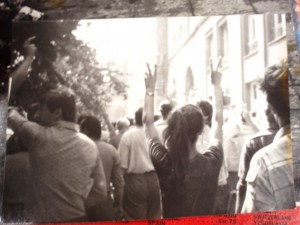
Solidarność (Solidarity) began during shipyard strikes in Gdańsk, led by Lech Wałęsa. In 1980, the first independent trade union formed in the Soviet bloc, and the sentiment of solidarity spread throughout the country.
The Soviets reacted by imposing martial law but the peaceful revolution prevailed. In Feb. 1989 round table talks began between the communist party and the leaders of Solidarity.
On June 4, elections were held and Solidarity led the new government. This day was marked by Poles around the world as “unbelievable” says Jan Grabowski, a history professor at the University of Ottawa.
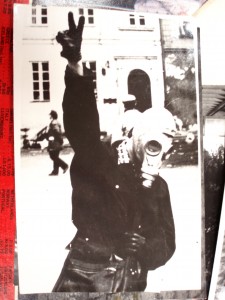
Grabowski was in Canada during the elections. He left Poland in 1988 when the regime loosened travel restrictions. He said he regretted leaving had he known freedom was so close.
“I simply thought that communism was this rock that would never budge,” Grabowski said. “I thought there was no future for any young person in Poland.”
During the eighties, Grabowski became a member of the Independent Student Union, an affiliate of Solidarity.
He printed leaflets and brochures he would scatter from the top of apartment buildings to inviting the people below to demonstrations, Grabowski said.
Once his landlord threw him out of his apartment and he carried a printing machine through the streets of Warsaw.
“I was wandering the streets of my fair city waiting to get arrested for this kind of behaviour,” he said.
He found refuge in his cousin’s apartment and continued his activity there. But after four years, his participation ended because he said he got tired of looking over his shoulder.
After the elections the communist oppression ended.
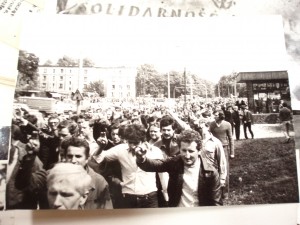
The political counselor at the Polish Embassy in Ottawa, Andrzej Farafa, was only nine-years-old at the time of the elections but he still remembers the severe food shortages.
“The economy was underdeveloped before change,” Farafa said who attributes economist Leszek Balcerowicz for successfully replacing the communism model with free-market reforms.
A contemporary Poland looks much different these days with shopping malls and well-stocked grocery stores. Farafa said it will be hard for his kids to understand the way things once were in Poland.
Lech Wałęsa, as the first President of the Republic of Poland, introduced capitalism and focused on foreign relations with the West.
Poland became a member of NATO in 1999. Since then, Polish troops have fought in Iraq and Afghanistan.
In 2004, Poland joined the European Union but continues to use its own złoty currency. Working with neighbouring countries is a form of Solidarity, said Farafa.
“It’s a reasoning that we use with the European states, you need to be a team player to achieve more,” Farafa said.
While high debts caused the European financial crisis in 2009, Poland was the only EU member nation to continue economic growth.
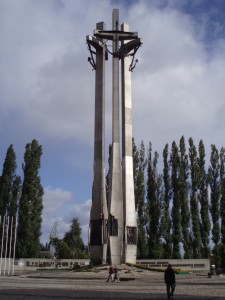
The introduction of capitalism and globalization brought success to the country along with some challenges.
Poland has an unemployment rate of 14 percent and reports say after joining the EU, economic migration increased and people left to find job opportunities elsewhere.
The sense of national unity has faded and for Krzysztof Kasprzyk, an original supporter of the revolution, some “people forgot about many lessons from Solidarity,” he wrote.
The origins of the revolution may be lost among the generation who were too young to remember tanks in the streets and military rule during martial law.
Farafa said people still refer to movement. It’s a reminder that if “we really want something we can unite and we can make a change,” he said.
Whatever happened to story
Documentation
Shannon Lough
Feb. 26, 2014
I had several interviews. The first was with Jeff Sallot, who worked for the Globe & Mail’s Moscow bureau during the collapse of the Soviet Union. He provided me with solid background information on the elections and the Solidarity movement.
The second interview was Jan Grabowski, a history professor at the University of Ottawa. The third interview was with Andrzej Farafa from the Polish Embassy. I also reached out to the Polish consulate in Toronto who connected me through e-mail with other sources including Krzysztof Kasprzyk, who wrote the unofficial anthem for the Solidarity movement.
The idea came from a document I obtained while studying in Poland. I got it while I was in Gdansk, where I learned about the Solidarity movement. It’s a transcript of an international conference held in Warsaw on discussing the 25th anniversary of the Independent Trade Union, Solidarnosc. I decided to do my story on the success of the Solidarity movement by overthrowing the oppressive communist regime in 1989.
I took the photo of the memorial in Gdansk in 2007, and the Solidarity photos I photographed copies of from a professor at Jagiellonian University in Krakow.
For my two documents:
Transcript of an interview with Jan Grabowski (attached)
I found him through searching online for people in the area that were specialists in Polish politics. I noticed that on the professor’s website his profile stated he had been in Warsaw in the 1980s and I contacted him for an interview on the subject.
The interview was extremely helpful because his memories were full of colour and he brought life to the story. He is also aware of Poland’s current situation because he travels four to five times a year for his work.
Transcript of the International Coference in Warsaw-Gdansk, August 29-31, 2005

I found the document while I was sorting through my books back at my parents house. I obtained the book while I was studying in Poland. I went on a trip to Gdansk to learn about the political history of the area and visited the memorial at the shipyard. I was given the text there.
It was helpful because it’s a reflection on the Solidarity movement by important figures within Poland. The most useful section was on the legacy of the movement and how it changed Poland after overthrowing communism.
Jan Grabowski
Professor/Professeur titulaire
Department of History/Département d’histoire
University of Ottawa/Université d’Ottawa
Desmarais Hall, room 9117, 55 Laurier East
Ottawa, Ontario K1N 6N5
(613) 562-5800 # 1292
Article: Solidarity movement
Telephone interview
Possible questions:
What was the atmosphere of Poland like during the 80s?
Did you take part of the Solidarity movement?
How did you feel about the outcome of events?
What did this peaceful protest do for the Polish people and how has the affected the way Poland is today?
Jan Grabowski:
There were two periods one was the time of 1980-81, that was after the strikes when Solidarity was finally formed and created then there was martial law with several years of oppression and then you had the re-emergence of the solidarity movement in 1989.
Can you tell me about the atmosphere in Poland during this time?
Imagine one day for instance that you go out from your house in the middle of the winter, it was 13th of December 1981, you see tanks and armoured personal carriers sitting out in front of your house and your telephone does work any more. You cannot leave the country, you cannot leave even your city. Everything is under iron law of the military. People get shot for their trouble too and you know it was a bleak bleak period of time.
The hopes were so high before and then from one day to another it went into complete despair.
Were you a part of the Solidarity movement?
Oh yeah, at that time in 1980-81 I was a student. I was a member of the equivalent of Solidarity in the student movement, it was called Independent Student Union, which was a solidarity affiliate among the students. And then I became a member of the Solidarity in the underground. I was involved in the underground printing presses printing information for the Solidarity movement between December 1981- 1985. My participation stopped, you people sometimes get tired after four years looking over your shoulder whether someone is going to arrest you. You simply need a pause and I took a pause after four years.
How did you manage to leave Poland?
After several years of martial law the regime mellowed a bit. By 85-86, Poles could travel a bit abroad so you could leave the country, it wasn’t easily, its as doable.
In 1988 I was invited to continue my PhD in Canada, so I left. (To Montreal)
Have you ever returned?
Well you know, I’m a working historian and I’m doing the history of Poland so I imagine at this point I’m going four/five times I am in Poland. So you could say, yes, very often.
Can you reflect on how you felt with the votes went through in 1989?
I was extraordinarily surprised. I was leaving Poland in 1988 and I was already a trained historian by craft and I could never ever ever thought it possible. When I left in 1988 I thought there was no future for any young person in Poland. It felt like you were looking at the world through a thick wall of glass. It was sort of an un-reality we called; the rules were oblique, strange, inhuman even. Then after one year the system seemed to collapse like a house of cards.
I simply thought that communism was this rock that would never budge, at least not in my lifetime. Had I known I would never have immigrated to Canada in 88. I would have certainly stayed on until after a year or so, I had already made my commitment.
I was very very surprised and of course over joyed too.
How old were you when you left?
I left when I was 26yrs at that point.
Do you think that it was the Solidarity movement that brought the fall of communism in Poland?
The Solidarity movement was of course instrumental in bringing it down but of course everyone will tell you that simply the system started to rot in the Soviet Union. It was already very shaky. And simply Polish society and solidarity took advantage of the fact that the centre of Soviet power had started to collapse. It was good fortune for everybody. Solidarity took advantage of the fact that Moscow became weakened and the Soviet system became so ill at heart that it couldn’t control its periphery anymore.
How do you think this movement has affected Poland today?
It’s amazing, you have to go there one day, it’s open society. I am certain you would find Poles your age exactly the same as your Canadian counterparts. They are now raised in the same Western culture and Polish society has it’s problems, especially young people. It’s a normal Western society with all of it’s problems and vices but parts of it are fairly optimistic family of developed nations. It’s amazing what was done in 25yrs. It’s not as wealthy as Canadian society of course but given the point that I remember in 1988 where the only merchandise you could buy was vinegar I would say it’s a major improvement.
How did you feel about Lech Walensa becoming the leader right after?
He’s a person of historical dimension, he’s a bit larger than life and he commits huge errors and he makes wonderful decisions too so he is such a complex individual that I would be lost to describe him but I think he was much better in opposition than once he became President. Once he became President parts of his character came to the fore but once he was leader in Solidarity even the whole union, he made tremendous decisions and he was brave and we all owe him a huge debt of gratitude.
Can reflect on a moment during when you were in the underground movement?
Once I was in the little printing press, it was heavy but I could lift if off the ground. We produced underground bulletins. We as myself or one or two of my colleagues. We had to change locations because people were afraid of stuff, of helping anyone to do with the underground. I remembered one sunny winter morning it was in 1983, in the midst of a very severe winter, my landlord threw me out with this printing machine and in my backpack I had a few thousand sheets of paper and stuff you need to print and I had no where to go with the bloody thing. Because nobody wanted to lend me their space anymore. That was an utter disappointment. People after two years of hiding in the underground movement were tired. I was wandering the streets of my fair city waiting to get arrested for this kind of behaviour. Finally I found a place with my very old cousin. She was then in her 80s and she remember still the partition and occupation of Poland in WWI. And she opened her very modest apartment and she invited me in. And that’s where I was producing the brochures and the information leaflets for Solidarity for some time.
What kind of things did you print?
Normally it was simply 100,000 leaflets inviting people to demonstrations. Or appeals ordered to liberate political prisoners. I would print these leaflets, cut them, and throw them out from different buildings so they would be spread out to the crowds downstairs. Sometimes our little shop would produce internal bulletins for Solidarity. Whatever was required basically by the Warsaw Solidarity organization.
Did you ever go to Gdansk?
Of course many times but without Solidarity.
What can you say of the spirit of the Polish people during this movement?
Once again, I was at that point in Canada so I was a secondary witness. I can only tell you what my friends and family said that everyone felt absolutely and unbelievably happy especially during the June 1989 elections where suddenly people found out that they could actually a vote.That they could vote for their people. It was so novel and so absolutely unbelievable. For me the equivalent was in Aug. 31. 1980 when Solidarity became legal, it was absolute discovery that my goodness things can change.
A new project will help expose hidden stories about Alberta’s colonial history in March, after a three-year dispute over a mural in an Edmonton subway station.
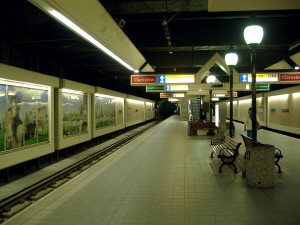
The 25-year-old mural is in the Grandin LRT station and depicts the legacy of the French-Canadian pioneer after which the station was named. Bishop Vital Grandin was instrumental in building Alberta, but he was also infamous for running the province’s residential schools.
Spearheaded by the Edmonton Arts Council and the city’s Aboriginal Relations Office, the soon-to-be-unveiled art project is still very much “on the hush,” according to Sylvie Nadeau, 61, the creator of the original mural and a proud Franco-Albertan.
Nadeau revealed she was involved on the new project but could not disclose its exact form or its expected location within the LRT station. She said however it would not be replacing her old work.
“I had created it with love, I had no idea,” the artist said about her first piece, adding that she was unaware of residential schools and their treatment of First Nations back when she completed her painting in 1989.
“It doesn’t change what happened but you can create something powerful with another perspective,” she said.
According to Nadeau, the leftmost panels of the original artwork were the “controversial ones” that drove some Edmontonians to react.
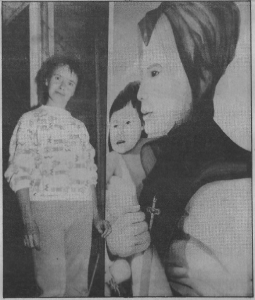
Amidst the hues of blue, green, black and brown, a Caucasian woman with a crucifix around her neck is holding a Métis toddler. In the background, there is a small gathering of faceless aboriginal people and, further behind them, a four-story building with many windows that resembles a residential school.
For some passing through the high-traffic LRT station, the mural might only be part of the décor but, for others, it still triggers unbearable memories.
In February 2011, an article published in the Edmonton Journal brought survivors of the notorious schools to speak out, the artist said. The criticisms of Nadeau’s work spread like wildfire—to the point that aboriginal and francophone community leaders were compelled to sit together and find a solution.
“Nobody talked about that mural for almost 25 years. And then, it stirred up so much controversy,” said Nadeau, who was willing to have the panel with the woman and child taken down.
But the city has rules against taking down—or even altering—public art, she said. The project’s committee was left with a daunting task: to complement the perspective in the original mural with a new set of ideas, giving aboriginal people agency in expressing their version of history.
For University of Alberta professor Roger Parent, an expert in semiotics who looks at how culture is represented through signs and symbols, the project will allow long buried narratives to resurface.
“We can see how now the varnish is starting to crack,” he said. “I think it’s bringing to light the wider issue of the representation of First Nations and their history in white mainstream society.”
Parent explained that, what the artist saw as an act to protect Métis children “disowned” by First Nations, the latter interpret as a benevolent portrayal of residential schools. The meaning of an art piece, he said, is mostly constructed in the heads of those watching.
“You’re dealing with an extremely significant cultural space and, at the same time, that painting has evoked so many different stories that have never been fully told, that have never been fully understood,” he said.
By the end of March, Nadeau said, passengers can expect to see some of these different stories as they ride through Grandin station.
“It’s not just about two ethnic groups,” the artist said.
“We’re all in this together.”
